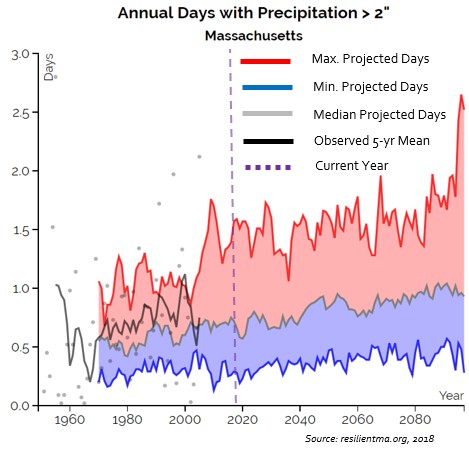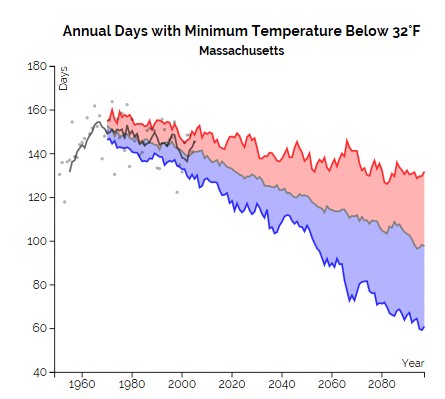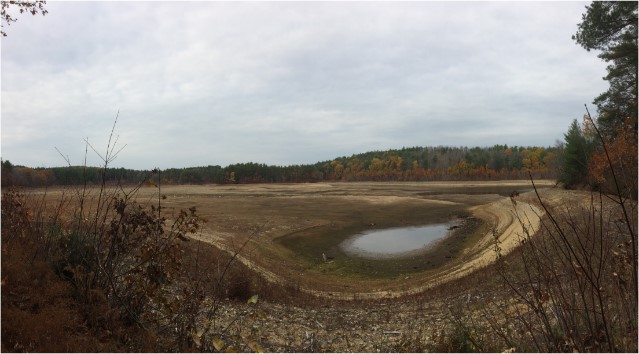Worcester's Natural Hazards and Priority Actions
Worcester's Natural Hazards:
Through the MVP planning process, the community identified the following three natural hazards (also referred to as extreme weather events) which are exacerbated by climate change:
Hazard: Flooding from extreme precipitation (heavy rain)
In the Northeast U.S., the amount of precipitation occurring during the most intense storm events is already increasing. In Worcester, the number of days with > 2” inches of precipitation is projected to double by 2050. Click here to learn more about flooding risks in Worcester and what you can do to prepare!

Hazard: Ice/snowstorms coupled with extreme cold
Annual precipitation volume in winter is projected to increase 30% and the number of annual days below freezing is projected to decrease up to 46% over the next 80 years due to climate change. With more winter precipitation falling as rain or freezing rain instead of snow, there is a greater chance of ice and freezing rain storms.

Hazard: Extreme heat coupled with drought
The Northeast U.S. is projected to experience a significant increase in the number and/or duration of heat waves. 2070 projections show 25 more days over 90°, making Massachusetts summers “feel” more like summers in the South by the end of the century.
In highly urbanized areas heat is exacerbated by the urban heat island effect. During summer, roofs and pavement absorb heat, creating the so-called urban heat island effect – often raising local ground temperatures as much as 22 degrees compared to less developed areas of the city. Extreme heat has public health implications as human health issues - including heat-related illnesses, asthma, and vector-borne diseases, which are all linked to temperature and subsequent impacts on air quality.
Heat and precipitation trends are also linked to the frequency and magnitude of drought. In Worcester, there have been 7 major droughts since 1930 (lasting 3-8 years each). Per the Statewide Hazard Mitigation and Climate Adaptation Plan, the total number of consecutive dry days (between precipitation events >1 mm) is projected to increase up to 12% (+2 days) in Massachusetts by 2050.

Priority Recommendations to Improve Resilience:
All recommendations can be found in the MVP report!
Priority Actions for Infrastructure Resiliency
Action A: Invest in Improved Management and Maintenance of the City’s Stormwater System
- Conduct system wide hydrologic/hydraulic drainage evaluation and modeling to ensure projects effectiveness, and make project prioritization.
- Develop comprehensive flood mitigation solutions for the City’s recurring flooding problems.
- Proceed with in-depth analysis of the most at-risk areas to flooding under future climate scenarios identified in the workshop preliminary analysis (see Appendix B).
- Consider design options for the underground Blackstone canal to address the recurring flooding in the Green Island area as it is located in a vulnerable floodplain and is home to many low-income residents.
Action B: Investigate a stormwater enterprise fund/stormwater utility fee to support enhanced stormwater management initiatives
- Establish a credit to incentivize green infrastructure, porous pavement.
Action C: Prioritize green infrastructure projects to mitigate urban heat island and reduce flooding
- Implement in areas adjacent to public right-of-way for dual benefits.
Action D: Develop a public outreach and education initiative
- Continue to educate residents on ways to mitigate the occurrence of frozen pipes related to extreme cold.
- Continue to promote water conservation amongst residents during droughts for in-home use and for landscaping.
- Promote adopt a catch basin program.
Action E: Implement adaptation/resiliency strategies to harden critical city-owned buildings
- Identify community schools within neighborhoods to test micro-pilot programs and techniques.
- Proceed with an assessment of Worcester public schools to address their heating and energy performance and become more resilient to extreme heat and cold. In the process, the buildings will be more efficient and sustainable (work on insulation problems and heat leaks).
- Identify the best location in City-owned buildings for emergency shelters/resiliency hubs with generators or other onsite power for emergency resources.
- Create a resilient building scoring system to prioritize building improvements and inform capital planning.
Action F: Advocate and assist in creating a resilient transportation network
- Advocate that WRTA and MBTA create and implement reliable contingency plans for commuters during extreme events.
- Identify bus routes at risk of flooding and develop a contingency plan for emergency route plan.
- Design and install bus shelters at popular bus stops where riders would be vulnerable to extreme heat or extreme cold exposure.
Action G: Assess the vulnerability of drinking water supply to future drought conditions
- Study impacts of increased development and increased incidence of summer droughts on existing water supply.
- Develop a public education program on the protection of potable water, “what we drink.”
Priority Actions for Societal Resiliency
Action A: Initiate an education program/campaign about climate change
- Use effective communication strategies, including the City’s website and social media, for public information related to preparedness.
- Develop a program for education on awareness of climate change impact and possible preparedness measures; e.g. talk to your neighbors and help others.
Action B: Improve the City’s emergency planning to incorporate climate change
- Determine if designated shelters are adequate and not vulnerable to current and future flooding.
- Identify strategies in partnership with kids for engaging families with limited English proficiency.
- Reach out to people through emergency messaging (opt-in vs all-in) focusing on identified neighborhoods with most at risk populations.
- Implement a flashing light warning system for snow emergencies.
- Expand social media use to communicate before/during/ after weather-related emergencies.
- Create a resiliency network to reach isolated populations.
- Create a sheltering plan (including heating/cooling) and communication plan to inform residents of an emergency and knowing what resources are available and where to go during an emergency, especially for most vulnerable populations.
- Create or confirm an emergency plan for assisted living and affordable housing residents (e.g. public health department and first responders).
Action C: Empower renters and property owners to prepare for climate change
- Develop education that is specific to renters and property owners to ensure everyone can prepare.
- Create a registration for landlord license and checklist to improve resiliency and protect renters.
Priority Actions for Environmental Resiliency
Action A: Protect open space and water resources
- Develop a detailed study to assess the possible impact of climate change on the City’s natural resources.
- Study options for implementing regulatory controls or policy changes addressing climate change (ex: legal mechanisms to promote green infrastructure, and protect open space areas).
- Continue to protect water resources from contamination from industrial properties by providing education on best practices.
- Provide education on upland fertilizer usage at higher elevations that seeps down to lower neighborhoods and waterways as more frequent extreme precipitations will add stress to the water system and will increase the risk for contamination.
- Require green infrastructure as part of all new development to reduce urban heat during extreme heat event and also increase stormwater retention/ filtering on site.
Action B: Improve waste collection practices
- Educate the community about special measures; “what to do” for waste collection during flooding/heat.
- Implement a City-wide food composting program.
Action C: Improve the tree canopy
- Continue to support the Right Tree, Right Place program.
- Create and adopt a tree replacement policy, including addressing tree pruning and maintenance.

